
Molinia caerulea, known by the common name purple moor-grass, is a species of grass that is native to Europe, west Asia, and north Africa. It grows in locations from the lowlands up to 2,300 m (7,546 ft) in the Alps. Like most grasses, it grows best in acid soils, ideally pH values of between 3.5 and 5, however, it can continue to live under more extreme conditions, sometimes to as low as 2. It is common on moist heathland, bogs and moorland throughout Britain and Ireland. Introduced populations exist in northeastern and northwestern North America.

Bromus hordeaceus, the soft brome, is an annual or biennial species of grass in the grass family (Poaceae). It is also known in North America as bull grass, soft cheat, and soft chess.

Rhynchospora alba, the white beak-sedge, is a plant in the sedge family, Cyperaceae. It is a tufted herbaceous perennial around 50 cm tall, with white inflorescences that flower in August. The fruit of the sedge is a small achene with a characteristic beak-like cap. It is dispersed by wind or falls by gravity, leading to individuals existing in tight clumps. The species favours wet, acidic and nutrient poor soils, thriving in Sphagnum-dominated bogs, but also peaty grasslands. As such, it is often used as a positive indicator for bog and mire ecosystem health.

Gahnia grandis is a tussock-forming perennial plant found in southeastern mainland Australia and Tasmania.
Oryza punctata is an annual grass in the rice genus Oryza, also known as red rice, related to cultivated rice O. sativa. O. punctata forms clumps or tussocks from 50–120 cm tall. It is a native to tropical Africa and Madagascar but is also found in Thailand and other parts of Indochina. O. punctata is a weed species in commercial rice growing operations although it appears to be rare in its native range. O. punctata has an IUCN status of least concern. It is not generally eaten or used as fodder by farmers but there is some evidence that it has been used as such during periods of famine. Due to the importance of the crop varieties of rice globally, the evolution of the Oryza genus as a whole has been studied extensively. A lot of information about O. punctata has been elucidated as a secondary benefit to this commercial research. O. punctata evolved some 5 million years ago in the second of two rapid radiation events that occurred in the Oryza L. genus.
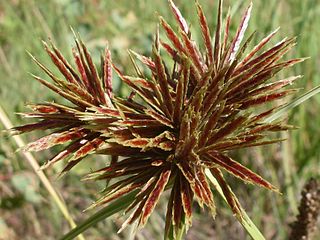
Cyperus congestus, commonly known as dense flat-sedge or clustered flat-sedge, is a sedge of the family Cyperaceae that is native to southern Africa mostly in South Africa, Lesotho and Namibia.
Cyperus zollingeri, commonly known as roadside flatsedge, is a sedge of the family Cyperaceae that is native to tropical areas of Australia, Africa and Asia.

Fimbristylis littoralis, commonly known as lesser fimbry or lesser fimbristylis, is a sedge of the family Cyperaceae that is native to many countries in Africa, Asia and Oceania including across much of northern Australia.

Schoenus compar is a species of sedge endemic to southern South Africa.
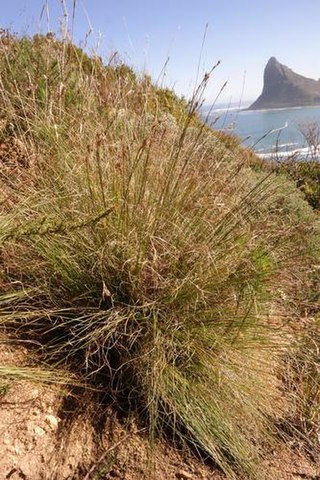
Schoenus graminifolius is a species of sedge endemic to the Cape Peninsula of South Africa.

Schoenus limosus is a species of sedge endemic to the KwaZulu-Natal and Eastern Cape provinces of South Africa. It is predominantly a species of wet grasslands, which explains its common name.
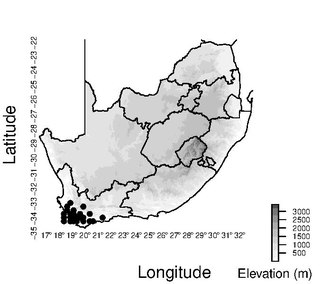
Schoenus crassus is a species of sedge endemic to south-western South Africa.
Carex arctogena is a member of the sedge family (Cyperaceae) which grows in high alpine areas. It is one of the few "bipolar" species; it has populations in Greenland, Scandinavia, Russia, Canada and southern South America. Plants in the far north and south appear to be genetically identical, having taken advantage of a similar niches on opposite ends of the globe.
Eleocharis confervoides is a species of plant in the sedge family (Cyperaceae). It is a perennial, submerged, aquatic and deeply rooted herb. It is known by its common name Algal bulrush and has lots of synonyms. The species has worldwide but very spotty distribution and is native in many tropical and subtropical regions in America, Asia and Africa. It inhabits in water, usually in shallow or deep lakes and ponds. The plant has slender stem with many branches, the leaves float in the water and flowers are usually emergent over the water surface. Fruiting occurs in fall. The most occurrences of plant appear in April and frequency of occurrences is increasing the last years

Rottboellia cochinchinensis is a species of grass known by the common names Itchgrass,Raoul grass, corngrass, Kokoma grass, Guinea-fowl grass, jointed grass, Shamwa grass and Kelly grass. It is a tall, tufted annual grass whose stems (culms) grow up to 3 metres in height with leaf-blades of up to 45 centimetres in length. The species flowers at the apex of culms in the form of spike-like racemes composed of paired spikelets. The common name Itchgrass comes from the bristly (hispid) leaf-sheath which can be irritating to the skin.
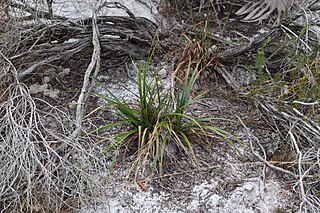
Rhynchospora megalocarpa, commonly called sandyfield beaksedge, is a species of flowering plant in the sedge family (Cyperaceae). It is native to North America, where it is found in the southeastern United States.

Schoenus inconspicuus is a species of sedge endemic to south-western areas of the Western Cape Province of South Africa.
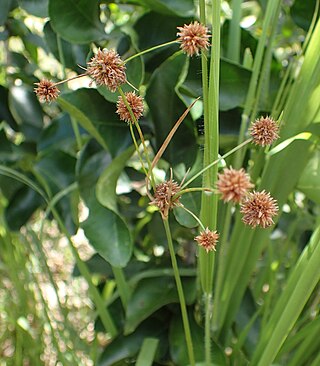
Rhynchospora holoschoenoides, known by the common name of fly beaksedge, is a member of the sedge family, Cyperaceae. It is a perennial herb, found throughout the Caribbean, Central and South America and western and southern Africa.
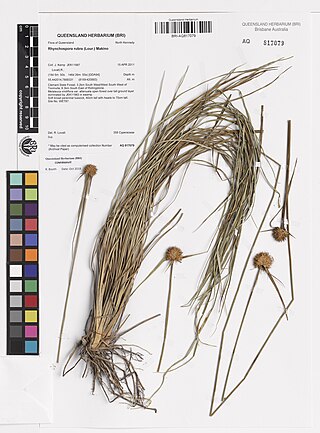
Rhynchospora rubra is a member of the sedge family, Cyperaceae. It found throughout Asia, Australia, and western and southern Africa.
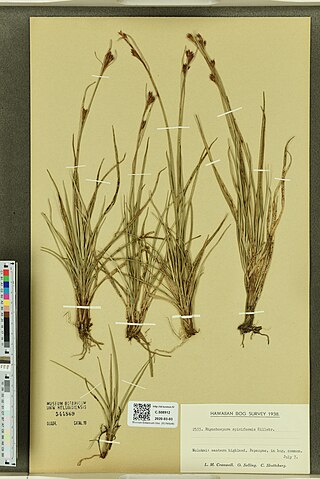
Rhynchospora chinensis, known by the common name of spiked beaksedge, is a member of the sedge family, Cyperaceae. It is a perennial herb, found in wetlands of Japan, Korea, eastern China, Mainland Southeast Asia, India, Australia, and Madagascar. It was once present in Sri Lanka, where it is now locally extinct. The subspecies R. chinensis subsp. spiciformis is endemic to Hawaii.















